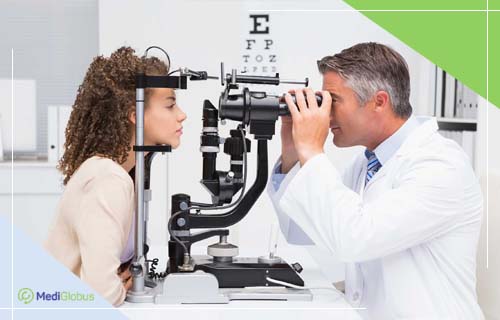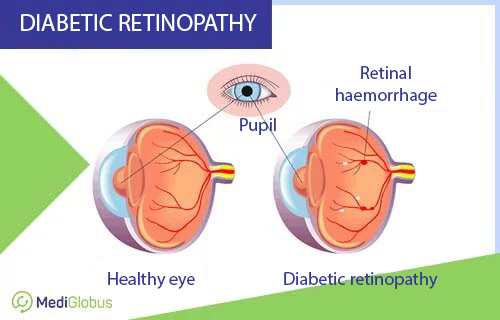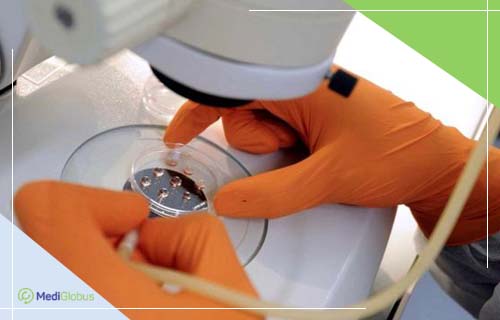1. Ophthalmology check-up |
2. Diagnosis of diabetic retinopathy |
3. Retinopathy treatment by stage |
4. Stem cell therapy |
5. Clinics for retinopathy treatment |
6. Cost of diabetic retinopathy treatment |
Diabetic retinopathy, also known as maculopathy, occurs in one in three adults with diabetes (according to the National Library of Medicine). At its early stages the disease is almost asymptomatic. If it is not treated in time, the retina will be affected leading to serious consequences, up to diabetic blindness. It is not possible to cure retinopathy completely. However, there are effective methods which can prevent the development of the pathology and allow the patient to retain their sight. In this article, we will tell you about modern treatments and clinics that specialise in treating this condition.
Listen to the article:
EARLY DETECTION OF DIABETIC RETINOPATHY
In the early stages of diabetic retinopathy, there is a much better chance of stopping the loss of vision. However, usually at the beginning patients do not feel any symptoms, so they end up seeking medical help too late. To avoid severe consequences and preserve vision, doctors recommend regular check-ups.
Foreign clinics have developed special check-up programmes for the early detection of eye diseases. Such ophthalmological diagnostics only take 1-2 days. After that the patient receives the results of diagnostics with detailed recommendations on the presence of abnormalities, either in person or by email. You can also take time out for a checkup when you are on holiday abroad.

DIAGNOSTIC TECHNIQUES FOR DIABETIC RETINOPATHY
Diabetic retinopathy can be suspected when a person has visual impairment associated with diabetes mellitus.
The main symptoms of diabetic retinopathy are:
Decreased visual acuity;
Flickers and floating dark spots in front of the eyes;
Pain and redness in the sclerae;
Retinal haemorrhages.
Accurate diagnosis is necessary before diabetic retinopathy can be treated. The main methods of examination are:
Ophthalmoscopy – establishes the presence of retinopathy.
Color Fundus Photography – determines the stage of the disease.
Fluorescence angiography – assesses the extent to which the vessels of the eye are affected.
Optical coherence tomography – examines the macula to establish the degree of macular edema.
You can find out more about diabetic retinopathy prevention, eye examinations abroad and sign up for a check-up by contacting the MediGlobus platform coordinator.
TREATMENT OF DIABETIC RETINOPATHY BY STAGE

Based on the examination, the doctor determines the stage of the disease and prescribes the appropriate treatment. There are 3 stages of the disease: non-proliferative (early stage), pre-proliferative (medium degree of retinal damage) and proliferative diabetic retinopathy (severe damage of the retinal vessels).
Retinopathy at an early stage without retinal vascular lesions is not treated. Patients only need to have a check-up every 2-4 months to monitor its progression. At this stage, it is advisable to keep blood sugar and blood pressure from rising.
If the examination shows changes in the retina, the doctor prescribes treatment with corticosteroids and anti-VEGF drugs. These medications help to reduce abnormal vascular growth and reduce retinal edema. The medication is injected directly into the vitreous body of the eye. The procedure is painless as it is performed under local anaesthesia. Currently, several anti-VEGF drugs approved by the FDA are successfully used in foreign clinics.
In addition, a procedure is performed to implant the drug into the vitreous body to treat the retina. The active ingredient is gradually released and acts over a period of 3-6 months, thus ensuring a lasting therapeutic effect. The treatment helps to reduce swelling and stop the inflammatory process.
In more advanced stages of retinopathy doctors resort to the following treatment methods:
Laser photocoagulation | During the procedure, a laser beam is used to glue the affected retinal vessels together. The treatment stops the growth of abnormal blood vessels and reduces the swelling of the retina. The procedure is performed under local anaesthesia and lasts 15 minutes on average. The complete course of treatment requires 1-2 sessions. |
Vitrectomy | This is a microsurgical procedure during which the affected vitreous body (the glandular transparent mass filling the eyeball) is partially or fully removed from the eyeball. The cavity is filled with a special silicone or gas. The operation is done through a micro puncture and is done under local or general anaesthesia. |
Learn how to treat diabetic retinopathy from a global MediGlobus medical specialist.
TREATING RETINOPATHY IN DIABETICS WITH STEM CELLS
Despite existing therapies such as laser photocoagulation and drug injections, their effectiveness may be limited if patients do not respond to therapy or experience side effects. Consequently, researchers around the world are actively exploring the potential of using stem cells to treat diabetic retinopathy.
The use of stem cells is a promising and promising approach to treating diabetic retinopathy. A unique feature of stem cells is their ability to migrate to diseased tissues and “take root” there, replacing diseased cells. Once in the centre of the pathology, they facilitate rapid regeneration of the diseased organ, including the retina. Diabetes treatment with stem cells leads to improvement of eye circulation, saturation of tissues with oxygen, and better vision. Besides, stem cells have a positive effect on the pancreas, restoring the functions of the organ and making it produce insulin. The treatment is completely safe and patients have hardly any side effects.
The use of stem cells in the treatment of diabetic retinopathy opens up a new era in medicine and could be a breakthrough in preserving visual function in patients. Marco Zarbin, a renowned US ophthalmologist, says the following about the treatment of retinopathy with stem cells:

“Research has demonstrated how the use of stem cells to replace damaged cells in the retina can improve visual acuity. This treatment is used for patients who have lost photoreceptors and pigment epithelial cells, a type of cell that cannot be regenerated and is essential for vision. The new treatment involves replacing diseased cells with embryonic or pluripotent stem cells extracted from the skin or other parts of the eye, which, once modified, are able to perform the same function as the damaged retinal cells. This therapy is now in trials and has shown very good results in people with retinal dystrophy, retinitis pigmentosa and diabetic retinopathy.”
WHERE TO GET TREATMENT FOR RETINOPATHY IN DIABETES

STEMBIO CLINIC in TURKEY
The STEMBIO Clinic in Turkey offers patients all the possibilities of cellular therapy. The clinic is internationally certified with ISO, cGMP and EATCB. Here, cells are harvested, processed and prepared for stem cell therapy. All procedures are carried out in accordance with international standards.

CELLTHERA CLINIC IN THE CZECH REPUBLIC
The medical centre specialises in the treatment of stem cells. For its compliance with high quality standards and the use of modern technologies, the clinic has been approved by the National Institute for Drug Control, the International Consortium for Cell Therapy and Immunotherapy (ICCTI), as well as the GMP.
In addition, diabetic retinopathy is treated with modern methods in the clinics:
HOW MUCH DOES IT COST TO TREAT DIABETIC RETINOPATHY IN 2023?
The cost of diabetic eye care varies from country to country, depending on the complexity of the condition, the method and the duration of the treatment. Average cost of retinopathy treatment abroad:
| Procedure | ||||
|---|---|---|---|---|
| Laser photocoagulation: | from $1,000 | from €2,500 | from $2,000 | from €2,900 |
| Vitrectomy | from $1,200 | from €1,800 | from $2,300 | from €2,000 |
Stem cell therapy for diabetes:
| Procedure | |||
|---|---|---|---|
| Stem cell therapy for diabetes | from $18,000 | from $14,000 | from €20,000 |
SUMMARY
Diabetic retinopathy is a pathology of the retinal vessels that can lead to blindness.
Early diagnosis can prevent the development of the disease and preserve vision.
Retinopathy in diabetics is treated both medically and surgically. Treatment is dependent on the stage of the disease.
Therapy of retinopathy with stem cells is a new and effective method, which allows restoring functions of the organs of vision in diabetics.
Treatment according to the latest standards is available in the Czech Republic, Turkey, Spain, and Germany.
For more information on diagnostics and treatment of eye diseases, please contact the specialists of MediGlobus. We will help with the choice of doctor and clinic, and organise your trip.
Sources:
- 1. National Library of Medicine
- 2. INature Communications
- 3. The Diabetic Retinopathy Clinical Research Network
- 4. Panretinal Photocoagulation Versus Ranibizumab for Proliferative Diabetic Retinopathy





